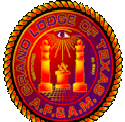
Masonic Symbolism: The Square and Compasses
Many feel that the interlaced Square and Compasses are ``the symbol of Freemasonry." This has been recognized as the Masonic emblem from at least the beginning of the 18th century. The United States patent Office took note of this in 1873. It told a flour manufacturer and the world: ``This device, so commonly worn and employed by Masons, has an established mystic significance, universally recognized as existing, whether comprehended by all or not, is not material to this issue. In view of the magnitude of the Masonic organization, it is impossible to divest its symbols, or at least this particular symbol—perhaps the best known of all—of its ordinary significance, wherever displayed." The manufacturer was denied the use of the Square and Compasses as a trademark.
It was about this time that some unknown ``inventor" added a letter ``G" in the center of the Square and Compasses. To many American Masons the emblem is not complete without this letter. This is not so in other countries, however. In other languages, God does not start with the letter ``G", neither does Geometry.
This is but one of dozens of symbols that Freemasonry employs to imprint on the mind ``wise and serious truths."
AN ANCIENT DOCUMENT
In tracing the genealogy of Freemasonry we eventually arrive at the date 1390 A.D., when the Regius manuscript, the oldest known and most important version of the Old Charges, is supposed to have been written. Traditions lead back to the creation of the world, and include most of the great teachers of mankind as Masons; but to those who insist upon applying the approved methods of historical research to the study of Freemasonry, the Regius Manuscript affords a starting point in cumulative documentary evidence relative to the direct ancestry of the fraternity. The Regius Manuscript, as it is known, is a poem written on sixty-four pages of vellum, handsomely bound. It was presented to the British museum by King George II, in 1757. It was at first catalogued as a poem of Moral Duties, and this may have caused its tardy discovery in 1839 as a Masonic document.
